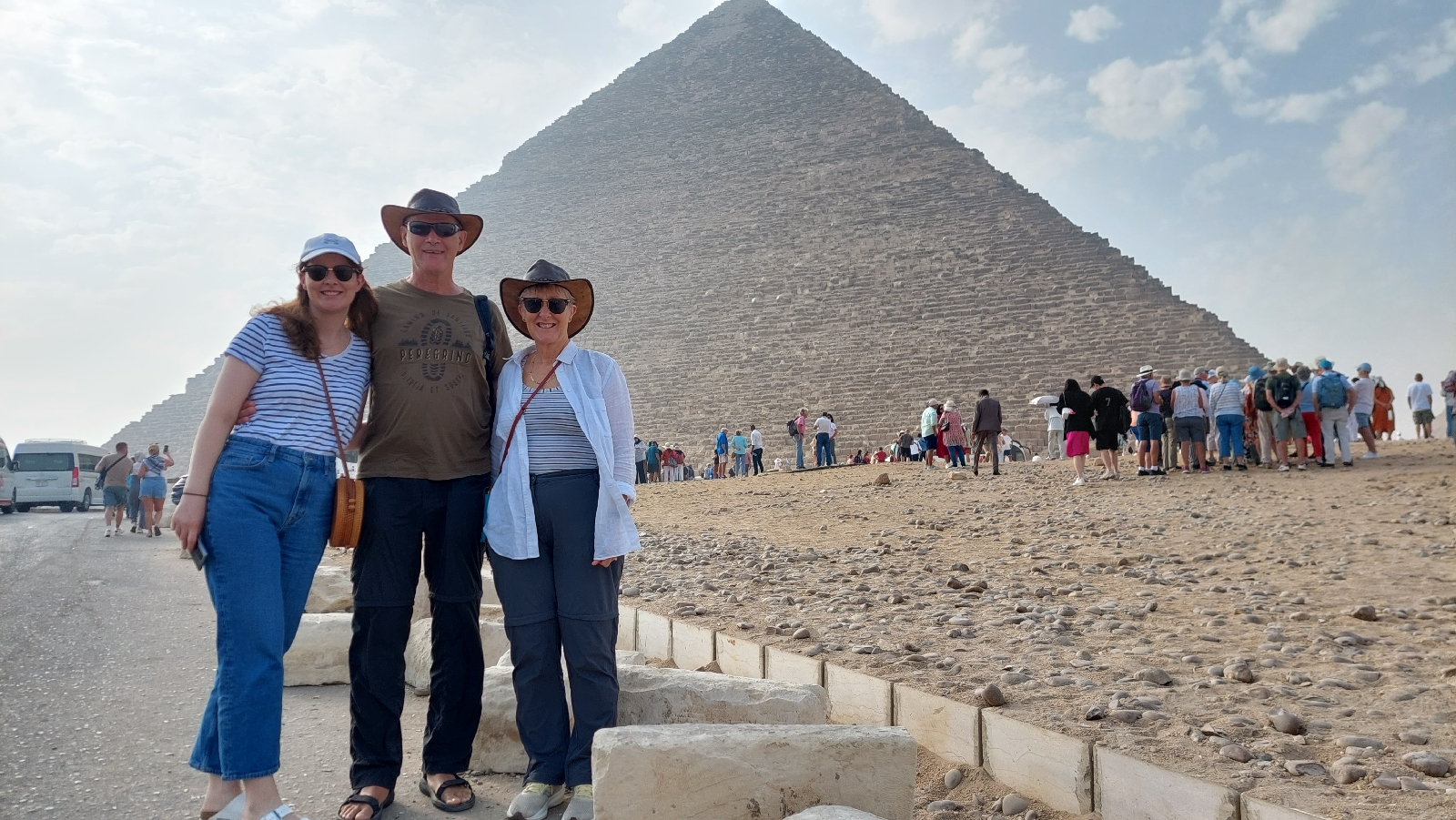Life On The Nile
Egypt reminded us of India in many ways. Same glorious chaos everywhere, same interesting driving style. One of our guides explained thay there are three simple rules in the Egyptian Road Code - You can drive: Anywhere; Anyhow; Anytime. Regarding someone driving the wrong way on a one way street: "It's not allowed. But it's not forbidden... "
It was amazing to think of the resources employed, technology developed, and time taken to build all the tombs and temples. This was especially evident with the Luxor Temple (singular) and the Karnak Temples (plural), joined together by the 2.8 km Avenue Of The Sphinxes.
No visit to Egypt could be complete without seeing the pyramids, and what better way to see them than from the inside?
It turns out that the ancient Egyptians weren't very tall, and that the pyramids weren't designed to be visited by tourists. Mary was able to crouch while climbing the tighter sections, whereas I had to crawl on hands and knees in parts. It was made more 'interesting' by the passageway being used for 2 way traffic, especially as some 'plus size' tourists almost filled the entire available space.
It was hot, crowded, and fabulous to be inside a monument almost 5000 years old!
There are lots of theories about how they designed and built the pyramids, but it was easy to compare each version as they fine tuned the design, starting with the earliest stepped pyramids, and ending with the famous smooth sided, perfectly proportioned ones. The first attempt at a smooth pyramid didn't go well, giving rise to the so-called Bent Pyramid - definitely a grave mistake...
Cairo wasn't merely pyramids and mummies, we also had the pleasure of a sufi dance performance. On Liz's excellent advice we took the precaution of wearing earplugs. I don't know what was more surprising - that the dancers could spin round so fast for so long while wearing 13kgs of skirts, or that they could do so with amplified accompanying music loudly reverberating around solid block walls.
What could combine the majesty of the pyramids with the colour of sufi dancing? The Valley of the Nobles and the Valley of the Kings. Everywhere one digs there seem to be ruins, and most still had the original colours, courtesy of not being exposed to sunlight for 4000 years or so.
Whew! How to recover from all these ancient wonders? Time for a break at the Winter Palace Hotel in Luxor, luxury from a bygone era, and more particular where Agatha Christie apparently wrote Death On The Nile.
The other defining feature of Egypt is undoubtedly the Nile itself. Cue another iconic experience, a Nile cruise.
Our ship was the Dahabiya Nora, dahabiyas basically being shallow, flat bottom barges with lateen sails fore and aft. The prevailing winds were going our way and typically were strong enough to overcome the current, so whenever possible we sailed in silence and tranquility, and at other times got a tow from an attendant tug.
When not lying back in deckchairs watching the world go by at walking pace, we stopped at numerous sites to view equally numerous tombs, temples, quarries, and mummified crocodiles, all accompanied by historical commentary from attentive tour guides. All of which was fascinating, none the least because different tour guides occasionally provided different earnest and apparently historically accurate explanations for the same statues and hieroglyphics. True, there were far more commonalities than differences, so I assume we got a reasonably accurate picture of the modern academic understanding of ancient Egyptian civilisation. Even so, I was constantly reminded of the quote that "History is the overlap of incomplete records with inaccurate memories".
After leaving the Nile cruise, we had one last famous site on the 'must see' list, the Abu Simbel temples built by Ramses II, one for himself and one for his favourite wife Nefetari. One quick aside - Ramses picking one wife as his special favourite and then building a spectacular temple in her honour must have caused some degree of jealousy amongst his other 67 wives. I couldn't help but wonder if the wives vying to gain ascendency in the domestic and political hierarchy had anything to do with Ramses having over 200 children...
The other, perhaps equally dramatic claim to fame of these two temples is that they were relocated between 1964 and 1968. They were originally sited below the waterline of what is now Lake Nasser, formed when Egypt built the Aswan High Dam. With the aid of UNESCO and a number of donor countries, the temples were dismantled block by block, statue by statue, and then reconstructed in a safe location. Once that was done, they built small hills over the top to recreate the original effect. Looking at them today you would swear the hills were real and the temples were as they were built all those thousands of years ago.
I started this blog comparing Egypt to India, and I think that is a fair comparison. Both are tourist attractions primarily due to their famous ancient history and monuments; both civilisations had fallen on hard times and been colonised by a string of foreign powers; both have again asserted their independence; and both are working hard to modernise to secure their future. Perhaps if they are successful at meeting their enormous challenges then we may return to futher sample hospitality and history. For now, we can tick both countries off our bucket lists, glad we visited but unlikely to return as we feel we have seen and done all we wish to see and do.
Next stop, Saudi Arabia...


























Comments
Post a Comment